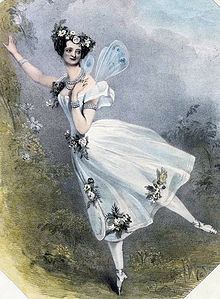- Marie Taglioni
-
 Lithograph by Chalon and Lane of Marie Taglioni as Flora in Didelot's Zéphire et Flore. London, 1831 (Victoria and Albert Museum/Sergeyev Collection).
Lithograph by Chalon and Lane of Marie Taglioni as Flora in Didelot's Zéphire et Flore. London, 1831 (Victoria and Albert Museum/Sergeyev Collection).
Marie Taglioni (April 23, 1804 – April 24, 1884) was a famous Italian/Swedish ballerina of the Romantic ballet era, a central figure in the history of European dance.
Biography
Taglioni was born in Stockholm, Sweden, to the Italian choreographer Filippo Taglioni and the Swedish ballet dancer Sophie Karsten, maternal granddaughter of the Swedish opera singer Christoffer Christian Karsten and of the Polish opera singer and actress Sophie Stebnowska. Taglioni rose to fame as a danseuse when her father (and teacher) created the ballet La Sylphide (1832) for her. Designed as a showcase for Taglioni's talent, it was the first ballet where dancing en pointe had an aesthetic rationale and was not merely an acrobatic stunt, often involving ungraceful arm movements and exertions, as had been the approach of dancers in the late 1820s.
Marie Taglioni was one of the most celebrated ballerinas of the romantic ballet, which was cultivated primarily at Her Majesty's Theatre in London, and at the Théâtre de l'Académie Royale de Musique of the Paris Opera Ballet.
In 1827 Taglioni left the Ballet of Her Majesty's Theatre to take up a three-year contract in Saint Petersburg with the Imperial Ballet (known today as the Kirov/Mariinsky Ballet). It was in Russia after her last performance in the country (1842) and at the height of the "cult of the ballerina", that a pair of her pointe shoes were sold for two hundred rubles, reportedly to be cooked, served with a sauce and eaten by a group of balletomanes.[1]
Taglioni was also known for shortening her skirt in the performance La Sylphide, which was considered highly scandalous at the time. She shortened all of her skirts to show off her excellent pointe work, which the long skirts hid. Her father was approving of the shortening of the skirt because he also wanted everyone to see how good his daughter was en pointe.
Taglioni retired from performing in 1847; for a time she took up residence at the Ca' d'Oro on the Grand Canal in Venice. When the ballet of the Paris Opera was reorganized on stricter, more professional lines, she was its guiding spirit. With the director of the new Conservatoire de danse, Lucien Petipa, and Petipa's former pupil, the choreographer Louis Mérante, she figured on the six-member select jury of the first annual competition for the Corps de ballet, held April 13, 1860.
Later she taught social dance to children and society ladies; she also took a limited number of ballet pupils. Her only choreographic work was Le papillon (1860) for her student Emma Livry, who is remembered for dying in 1863 when her costume was set alight by a gas lamp (limelight) used for stage lighting. Taglioni lived much longer, dying in Marseille in 1884. Johann Strauss II composed the Marie Taglioni Polka (Op. 173) in her honour, using music from ballets in which she had appeared.
She also danced in Pas de Quatre with Carlotta Grisi, Lucille Grahn, and Fanny Cerrito in July 1845.
References
- ^ Kassing, Gayle (2007). History of dance: an interactive arts approach. Human Kinetics. p. 131. http://books.google.com/books?id=_lLoTsT2X5EC&pg=PA131.
- Attribution
 This article incorporates text from a publication now in the public domain: "Taglioni, Marie". Dictionary of National Biography. London: Smith, Elder & Co. 1885–1900.
This article incorporates text from a publication now in the public domain: "Taglioni, Marie". Dictionary of National Biography. London: Smith, Elder & Co. 1885–1900.
External links
 Media related to Marie Taglioni at Wikimedia Commons
Media related to Marie Taglioni at Wikimedia Commons- Marie Taglioni, the Italian Ballerina
- Marie Taglioni (1804-1884): A life on toe tip (web presentation of the Taglioni collection in the Netherlands Music Institute)
Categories:- Prima ballerinas
- Italian ballet dancers
- Ballet teachers
- Swedish people of Italian descent
- 1804 births
- 1884 deaths
- Paris Opera Ballet dancers
- Burials at Montmartre Cemetery
Wikimedia Foundation. 2010.

